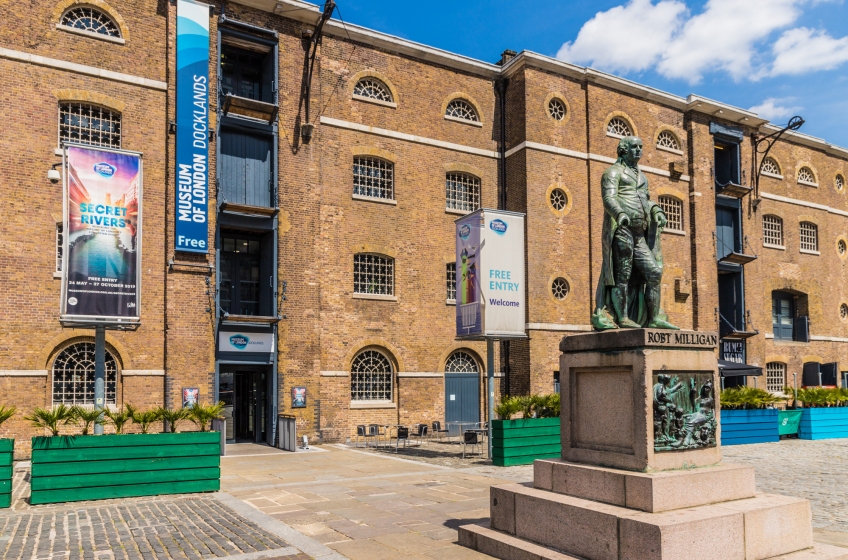Discover London Docklands | A Visitor's Introduction to London Docklands
Once a thriving port and industrial hub, the Docklands has undergone a remarkable transformation over the last few decades. Today, it is known for its modern skyscrapers, luxury residential developments, and cultural hotspots, all set against a backdrop of historic docks and waterways.
Recommended London Docklands Hotels
Why Are The London Docklands Worth a Visit?
The Docklands are worth a visit for their compelling combination of history, architecture, and urban renewal. From their heritage as one of the world's busiest ports to the sleek modern skyline dominated by Canary Wharf, the Docklands capture London's evolution over centuries. Visitors can delve into their maritime past at the Museum of London Docklands, enjoy stunning riverside walks, or marvel at the futuristic architecture and public art installations that define their present-day character.
The area’s redevelopment has also brought a wealth of dining, shopping, and entertainment options, making it an ideal spot for both history enthusiasts and those seeking contemporary leisure experiences. Add to that the stunning views along the Thames and the nearby Royal Docks, and it’s clear why the Docklands has become a destination in its own right.
London Docklands Highlights
1. Museum of London Docklands: Housed in a Grade I listed Georgian warehouse, the Museum of London Docklands tells the story of the Thames and the Docklands area from Roman times to the present day. Exhibitions cover everything from the transatlantic slave trade to the Blitz and the redevelopment of Canary Wharf. A visit here provides invaluable context to the Docklands' history and its pivotal role in London’s development.
2. Canary Wharf: The modern heart of the Docklands, Canary Wharf is a financial district with a striking skyline of glass-and-steel towers. But it’s not all business here; the area is home to high-end shopping centres, riverside restaurants, and public art installations. Visit the Crossrail Place Roof Garden, for a stunning space featuring exotic plants and beautiful views.
3. Greenwich Peninsula and The O2: Just a short distance from Canary Wharf, Greenwich Peninsula is known for The O2, one of London’s premier entertainment venues. It hosts concerts, sporting events, and exhibitions throughout the year. For the adventurous, the ‘Up at The O2’ experience offers a guided climb over the arena’s roof, providing spectacular views of the River Thames and the city skyline.
4. Trinity Buoy Wharf: This quirky cultural space, located at the confluence of the River Thames and River Lea, is a haven for artists and creatives. The area is home to London’s only lighthouse, Container City (a colourful community of studios made from repurposed shipping containers), and the Faraday Effect, a sound installation that plays a continuous composition inspired by the Thames tides.
5. The Royal Docks: The Royal Docks, encompassing the Royal Victoria Dock, Royal Albert Dock, and King George V Dock, offer a mix of water sports, dining, and cultural experiences. Visitors can take a ride on the IFS Cloud cable car for a bird’s-eye view of the docks or visit the ExCeL London exhibition centre. The area is also home to innovative floating hotels and eateries like the Good Hotel London, a social enterprise offering boutique accommodation on the water.
6. Thames Barrier Park: Situated in Silvertown, Thames Barrier Park is an award-winning green space that offers beautiful views of the Thames Barrier, a critical flood defence for the city. The park’s innovative landscaping, with its geometric hedges and colourful gardens, makes it a peaceful spot for a stroll or a picnic, away from the bustling city centre.
7. Docklands Sailing and Watersports Centre: For those seeking a more active experience, the Docklands Sailing and Watersports Centre on Millwall Outer Dock offers sailing, kayaking, windsurfing, and paddleboarding. It’s a great way to experience the Docklands from the water and see the area’s skyline from a unique perspective.
8. Limehouse Basin and Narrow Street: Limehouse Basin, connecting the Regent’s Canal and the Thames, is a picturesque spot known for its narrowboats and historic warehouses. Nearby Narrow Street, with its cobbled path and riverside views, offers a glimpse into the Docklands' past, with iconic pubs like The Grapes, which has stood here for over 500 years.
Practical Advice for Visitors
Getting There and Around: The Docklands is well-connected by public transport, making it easy to reach and navigate. The Docklands Light Railway (DLR) is the primary mode of transport, linking the area with the City of London and further east towards Stratford and Woolwich. Canary Wharf is also served by the Jubilee Line on the London Underground and the Elizabeth Line, which provides quick access to central London and Heathrow Airport. The Thames Clippers river service is another scenic way to reach the Docklands.
Best Time to Visit: The Docklands can be enjoyed year-round, but the summer months (June to August) are ideal for exploring its outdoor attractions and waterfront areas. Many events and outdoor festivals take place during this period, making it an especially vibrant time to visit.
Food and Drink: The area boasts a diverse food scene, from upmarket restaurants in Canary Wharf like Plateau and Roka, to casual eateries and food markets. Trinity Buoy Wharf is known for its unique dining options, such as Fatboy’s Diner, a retro American diner, and Bow Creek Café, serving delicious brunches by the water.
Accessibility: The Docklands is generally accessible, with step-free access available at most DLR and Jubilee Line stations, as well as along many of the riverside paths and walkways. Canary Wharf’s shopping centres and public spaces are also designed to accommodate wheelchair users and those with limited mobility.
Safety and Security: The Docklands is considered a safe area for tourists, with a strong presence of business and residential communities. As with any major city, it’s advisable to stay aware of your surroundings and keep an eye on personal belongings, especially in busy areas like Canary Wharf and the O2.
Shortlist
- Your Shortlist is empty

